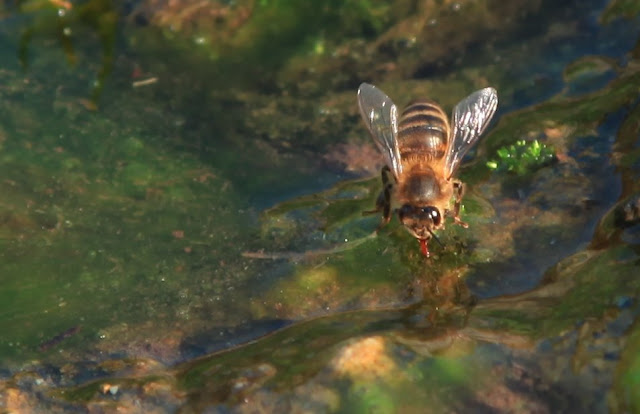We have recently enjoyed what has felt like the first taste of Spring. Yesterday I spent a while watching and photographing the bees as they excitedly made the most of the calm and warm day . At the hive entrances , large amounts of gorse pollen was being brought in , as well as the odd yellow-dusted worker returning from the willow blossom.
The Spring build up is quite slow on Bardsey , probably because of the exposed nature of the island and also because their nectar sources don’t really begin to appear in any quantity until late May . The first of these is the wonderful salt-tolerant Thrift (‘Sea-Pink’) which carpets much of the coastal heath and ancient earthen banks (‘Clodddiau’) .Nestled among their taller neighbours are the vivid blue flowers of Squill , which the bees also like to visit. Literature suggests that Thrift can produce a honey surplus in favourable conditions but I have yet to observe this happen . The usual time for the main honey flow has been during late June and into July , corresponding to the flowering of the abundant white clover. Mixed in , for extra flavour , the bees add nectar from Brambles , Bird’s-Foot Trefoil and Bell-Heather.
I have been pleasantly surprised at the consistent harvest of honey that we have had over the last eight years , usually a modest 30-40 lbs per hive. I sacrificed some of the honey yield last year for the sake of increasing the number of colonies. I now have six hives. I’m hoping this will help meet the demand for ‘Bardsey Honey’ at our cafe/craft shop which regularly runs out part way through the summer.
Some of the advantages of having such a unique and isolated apiary include being largely beyond sources of disease and the re-infestations that can affect mainland bees. I have not seen a Varroa mite in my hives for at least three years now ,much to my relief. However , one of the down-sides of isolation is the weakening affect of in-breeding. While I still had my bees in Conwy I would regularly bring nucleii over to enrich the gene-pool. More recently though , without my Conwy bees and with the difficulty of transporting nucs , I have begun to use bought-in queens. I will be watching with interest this season to see how they perform compared with their in-bred predecessors.
The sheep and cow proof apiary.
Bees bringing pollen loads back from Gorse (orange) and Willow (yellow).
It's useful to have a landing pad when you're arriving home tired and heavily laden !
Glass crown-boards enable me to check on the bees without disturbing them too much.
" Buzz off....this is my flower !"
Working on the Willow...
Working on the Gorse....
Working on the Hebe..










Amazing pictures of the bees - a real breath of spring to see the bright pollen and the close-ups of the flowers. They'd make wonderful cards....
ReplyDeleteI always enjoy the blog but thought this month's was exceptional. Thank you all.
Interesting thoughts
ReplyDelete